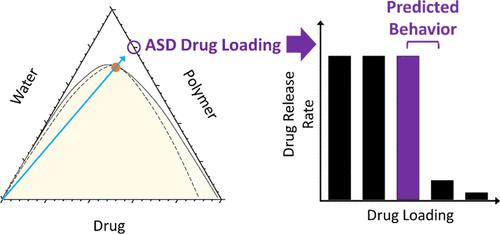当前位置:
X-MOL 学术
›
Mol. Pharmaceutics
›
论文详情
Our official English website, www.x-mol.net, welcomes your feedback! (Note: you will need to create a separate account there.)
Dissolution Mechanisms of Amorphous Solid Dispersions: Application of Ternary Phase Diagrams To Explain Release Behavior
Molecular Pharmaceutics ( IF 4.9 ) Pub Date : 2024-03-12 , DOI: 10.1021/acs.molpharmaceut.3c01179 Alexandru Deac 1 , Christian Luebbert 2 , Qingqing Qi 1 , Reagan M. Courtney 1 , Anura S. Indulkar 3 , Yi Gao 3 , Geoff G. Z. Zhang 3 , Gabriele Sadowski 2 , Lynne S. Taylor 1
Molecular Pharmaceutics ( IF 4.9 ) Pub Date : 2024-03-12 , DOI: 10.1021/acs.molpharmaceut.3c01179 Alexandru Deac 1 , Christian Luebbert 2 , Qingqing Qi 1 , Reagan M. Courtney 1 , Anura S. Indulkar 3 , Yi Gao 3 , Geoff G. Z. Zhang 3 , Gabriele Sadowski 2 , Lynne S. Taylor 1
Affiliation

|
The use of amorphous solid dispersions (ASDs) in commercial drug products has increased in recent years due to the large number of poorly soluble drugs in the pharmaceutical pipeline. However, the release behavior of ASDs is complex and remains not well understood. Often, the drug release from ASDs is rapid and complete at lower drug loadings (DLs) but becomes slow and incomplete at higher DLs. The DL where release becomes hindered is termed the limit of congruency (LoC). Currently, there are no approaches to predict the LoC. However, recent findings show that one potential cause leading to the LoC is a change in phase morphology after water-induced phase separation at the ASD/solution interface. In this study, the phase behavior of ASDs in contact with aqueous solutions was described thermodynamically by constructing experimental and computational ternary phase diagrams, and these were used to predict morphology changes and ultimately the LoC. Experimental ternary phase diagrams were obtained by equilibrating ASD/water mixtures over time. Computational ternary phase diagrams were obtained by Perturbed Chain Statistical Associating Fluid Theory (PC-SAFT). The morphology of the hydrophobic phase was studied with fluorescence confocal microscopy. It was demonstrated that critical point (plait point) composition approximately corresponded to the ASD DL, where the hydrophobic phase, formed during phase separation, became interconnected and hindered ASD release. This work provides mechanistic insights into the ASD release behavior and highlights the potential of in silico ASD design using phase diagrams.
中文翻译:

非晶固体分散体的溶解机制:应用三元相图解释释放行为
近年来,由于制药管道中存在大量难溶性药物,无定形固体分散体(ASD)在商业药品中的使用有所增加。然而,ASD 的释放行为很复杂,目前仍不清楚。通常,ASD 的药物释放在较低载药量 (DL) 时快速且完全,但在较高载药量 (DL) 时变得缓慢且不完全。释放受到阻碍的 DL 称为一致性极限 (LoC)。目前,还没有预测 LoC 的方法。然而,最近的研究结果表明,导致 LoC 的一个潜在原因是 ASD/溶液界面处水诱导相分离后相形态的变化。在本研究中,通过构建实验和计算三元相图,从热力学角度描述了 ASD 与水溶液接触的相行为,并用于预测形态变化并最终预测 LoC。通过随时间平衡 ASD/水混合物获得实验三元相图。通过扰动链统计缔合流体理论(PC-SAFT)获得计算三元相图。用荧光共焦显微镜研究疏水相的形态。结果表明,临界点(辫点)组成大致对应于 ASD DL,其中相分离过程中形成的疏水相相互连接并阻碍 ASD 释放。这项工作提供了对 ASD 释放行为的机制见解,并强调了使用相图进行计算机 ASD 设计的潜力。
更新日期:2024-03-12
中文翻译:

非晶固体分散体的溶解机制:应用三元相图解释释放行为
近年来,由于制药管道中存在大量难溶性药物,无定形固体分散体(ASD)在商业药品中的使用有所增加。然而,ASD 的释放行为很复杂,目前仍不清楚。通常,ASD 的药物释放在较低载药量 (DL) 时快速且完全,但在较高载药量 (DL) 时变得缓慢且不完全。释放受到阻碍的 DL 称为一致性极限 (LoC)。目前,还没有预测 LoC 的方法。然而,最近的研究结果表明,导致 LoC 的一个潜在原因是 ASD/溶液界面处水诱导相分离后相形态的变化。在本研究中,通过构建实验和计算三元相图,从热力学角度描述了 ASD 与水溶液接触的相行为,并用于预测形态变化并最终预测 LoC。通过随时间平衡 ASD/水混合物获得实验三元相图。通过扰动链统计缔合流体理论(PC-SAFT)获得计算三元相图。用荧光共焦显微镜研究疏水相的形态。结果表明,临界点(辫点)组成大致对应于 ASD DL,其中相分离过程中形成的疏水相相互连接并阻碍 ASD 释放。这项工作提供了对 ASD 释放行为的机制见解,并强调了使用相图进行计算机 ASD 设计的潜力。



























 京公网安备 11010802027423号
京公网安备 11010802027423号